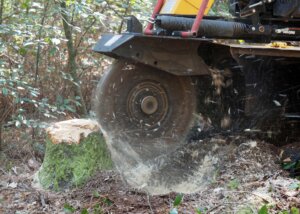
For as long as trees have grown among us, they have been harvested. And oftentimes, the stumps have been left behind, because stump removal has long been rib-cracking, slipped disc-provoking work.
Today, a modern stump grinding machine operates by remote joysticks, much like operating a drone or playing Super Mario. That is, if Mario had 45 steel teeth on a jaw rotating faster than your lawnmower’s blade, shredding an oak’s remnants into instant sawdust.
Jason Knapp, owner of K&S Professional Stump Removal in Mobile, owns such a machine. The SG75 Bandit combines robotics, remote sensing and metallic brawn in a $75,000 package. It is similar in size to an SUV. It is similar in demeanor to a wolverine.
“We have much more technology now than in the past,” says Knapp, alluding to the days of old when removing stumps required hardened muscles, strong backs and copious amounts of Bengay. “We have more technology now.
“Older machines are very manual, relying on levers and hydraulics,” Knapp adds. “Mine is remote control.”

Admittedly it is a bit unsettling, watching a 4,600-pound metallic device, larger than a minivan, meander through a wooded backyard — without a driver. The operator stands about 10 feet away, commanding all aspects of the 74-horsepower apparatus from a remote-control device’s tiny joysticks.
“There are many advantages to running the machine remotely,” Knapp adds. “It offers much greater visibility. I can monitor everything simply by walking around the machine as it works. And for safety, I can stand out of the way of flying debris.”
Actually, the machine itself does a good job of debris containment, Knapp says, but wayward wood occasionally flies out. He recalls, “I once had a large chunk hit me in the face. I’m glad my helmet and face shield were on.”
Machine design is different than the lumberjack wannabes of yesteryear. The 27-inch diameter wheel’s teeth are more like iron square pegs than cutting tools. It bites and pulls rather than cuts.
There is no manual digging and uprooting a stump with shovels. “As the wheel spins, the teeth grab and dig in the wood, but not so much of cutting it,” Knapp notes. “With sheer force the teeth knock off chunks of stumps continuously.”
The process is so fast, saw dust and fragments flying off the surrendering stump resemble a flowing stream. Within minutes an excavation marks the spot were a stump used to be.

The unit’s driving wheels are embedded in a rotating track, just like an army tank. Also like an army tank, the Bandit can travel over almost any terrain. And it does, with the operator walking along close by.
Once onsite, the Bandit is a sight to behold. “Watching the machine work is impressive,” says Fairhope customer, Jaime Cooper, who watched the machine decimate seven stumps in her yard. “It was cool watching him drive it and not be sitting in it.”
Knapp, a college music major who performs with the Mobile Opera, is relatively new to the stump grinding business. His company is co-owned with his father, Mike Knapp. During the pre-stump days, the son’s experience included industrial pressure washing, security guard work, forklift driver, warehouse employee and the night shift in a Mobile barbecue restaurant.
In July 2021, after discussions and training from Tennessee family members who were already successful in the stump removal trade, Knapp brought newly learned skills home. “I felt I could do it here. I felt it was the right time for me,” the Alabama relative recalls.
He decided to enter the field — lawns, yards and anywhere else stumps reside but should not. Though his Tennessee relatives taught him the ropes, he also learned by on-the-job experience.
“Each stump is different. Each has a personality. You never know how it will react until you start grinding it,” Knapp recalls.
“Some trees are more accommodating than others.” He gives examples: “Oaks are fairly easy to cut and remove. Also, cedar trees are like cutting butter.”
That’s the good news.
The bad news is two-fold. First, Southern pine is one of South Alabama’s most prolific growers. But second, according to Knapp, “Pine stumps don’t go down without a fight. It is at times difficult to get a bite on a pine stump and pull it out. Pines also have sticky sap that causes many problems for us. It sticks to everything.”
As in any good plan, start with the roots, if possible. “If roots are visible, I try to extract it first, before the stump,” Knapp says. “I visualize where the roots are, find it, then grind it.” After that, on to the stump.
Trees are often historical markers. A 300-year-old oak for example can tell many tales when digging up its roots. “Trees bring along with them whatever surrounds them,” Knapp adds. For example workers may have laid tools beside a trunk. Children could have played with toys under shady branches, early settlers possibly met under an oak’s shade, 200 years ago.
“I was working a job in Fairhope next to a church when a metal rod shot out,” he recalls. “The stump cutter’s teeth grabbed it and spit it out. I was lucky it didn’t hit me.”
“The homeowner said it could have been there since the Civil War, when the church was occupied by Union troops.” The customer kept the historic shrapnel.

As one might imagine, in South Alabama, where rain is common on days ending in Y, trees are plentiful. There is work for everybody and stump grinders are a close-knit bunch.
“We help each other,” he says. “I receive calls from other grinders asking if I can take a job that they are too busy to do. I also return the favor.”
Summer is the busiest time, but all year is steady. “Often, customers will have trees cut down but leave the stumps. Later, after getting tired of mowing grass around a stump or even just tired of looking at it, they call me,” he adds.
During peak months, K&S will grind hundreds of stumps, depending on the job. The biggest job to date was 350 stumps. It took him two and half days.
All in a days’ work for what was once a strong back and brawny muscle occupation. Today, shovels are replaced by joysticks. Not long ago, the grueling tasks of just one extraction, grinding and chipping, took hours. Now it is a matter of mulch in minutes.
Emmett Burnett and Mike Kittrell are Mobile-area freelance contributors to Business Alabama.
This article appears in the March 2023 issue of Business Alabama.



